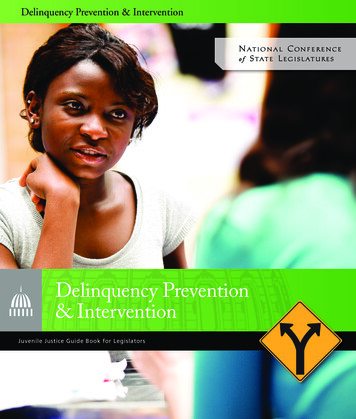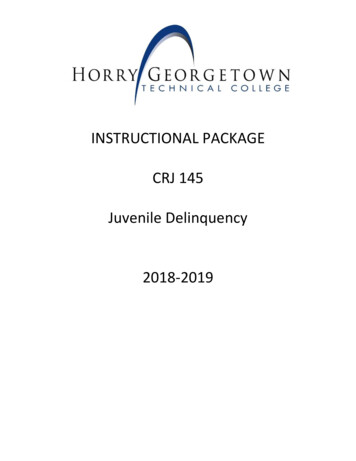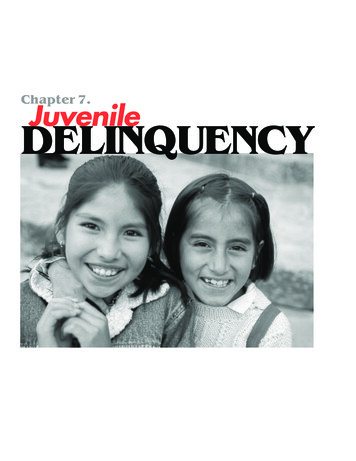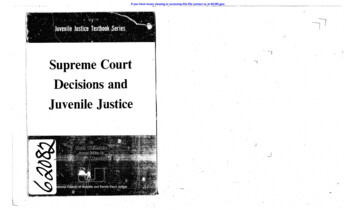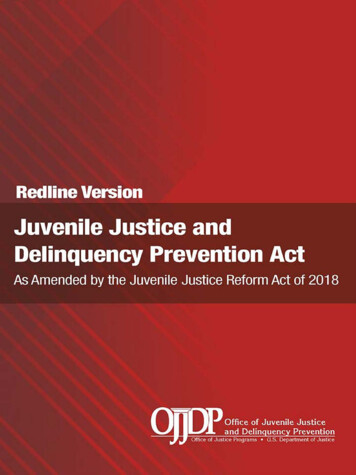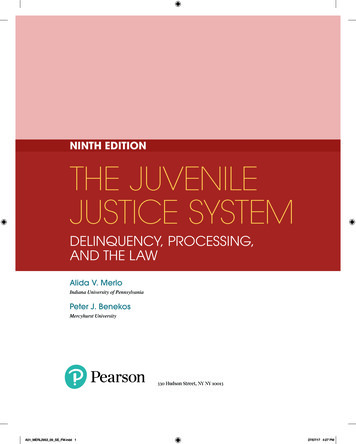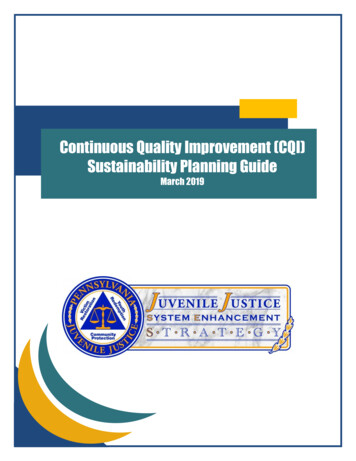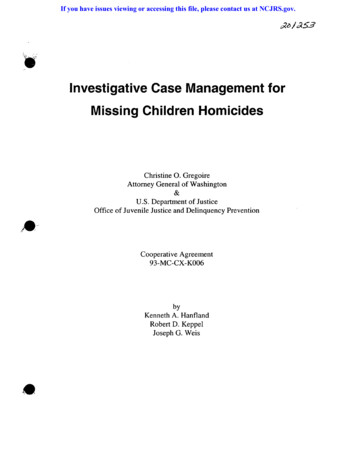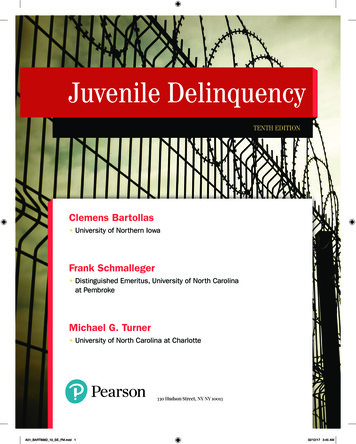
Transcription
Juvenile DelinquencyTENTH EDITIONClemens Bartollas University of Northern IowaFrank Schmalleger Distinguished Emeritus, University of North Carolinaat PembrokeMichael G. Turner University of North Carolina at Charlotte330 Hudson Street, NY NY 10013A01 BART8882 10 SE FM.indd 102/12/17 3:45 AM
Vice President, Portfolio Management: Andrew GilfillanPortfolio Manager: Gary BauerEditorial Assistant: Lynda CramerField Marketing Manager: Bob NisbetProduct Marketing Manager: Heather TaylorDirector, Digital Studio and Content Production: Brian HylandManaging Producer: Jennifer SargunarContent Producer: Rinki KaurManager, Rights Management: Johanna BurkeOperations Specialist: Deidra SmithCreative Digital Lead: Mary SienerManaging Producer, Digital Studio: Autumn BensonContent Producer, Digital Studio: Maura BarclayFull-Service Management and Composition: Integra SoftwareServices Pvt. Ltd.Full-Service Project Manager: Gowthaman SadhanandhamCover Designer: StudioMontageCover Art (or Cover Photo): Bert Flint/ShutterstockPrinter! Binder: I.SC Communications, IncCover Printer: Phoenix Color/HagerstownText Font: ITC Century Std LightCopyright @2019, 2014, 2011 by Pearson Education, Inc. or its affiliates. All Rights Reserved. Manufactured in the United States ofAmerica. This publication is protected by copyright, and permission should be obtained from the publisher prior to any prohibited reproduction,storage in a retrieval system, or transmission in any form or by any means, electronic, mechanical, photocopying. recording, or otherwise. Forinformation regarding permissions, request forms, and the appropriate contacts within the Pearson Education Global Rights and Permissionsdepartment, please visit www.pearsoned.com/permissions.Acknowledgments of third-party content appear on the appropriate page within the text.PEARSON and ALWAYS LEARNING are exclusive trademarks owned by Pearson Education, Inc. or its affiliates in the U.S. and/orother countries.Unless otherwise indicated herein, any third-party trademarks, logos, or icons that may appear in this work are the property of their respective owners, and any references to third-party trademarks, logos, icons, or other trade dress are for demonstrative or descriptive purposes only. Such references am not intended to imply any sponsorship, endorsement, authorization, or promotion of Pearson’s productsby the owners of such marks, or any relationship between the owner and Pearson Education, Inc., authors, licensees, or distributors.Library of Congress Cataloging-in-Publication DataNames: Bartollas, Clemens, author. Schmalleger, Frank, author. Turner,Michael G., author.Title: Juvenile delinquency / Clemens Bartollas, University of Northern Iowa,Frank Schmalleger, Emeritus, University of North Carolina at Pembroke,Michael G. Turner, University of North Carolina at Charlotte.Description: Tenth Edition. Hoboken: Pearson, [2019] Revised edition ofJuvenile delinquency, [2014]Identifiers: LCCN 2017040172 ISBN 9780134558882 ISBN 013455888XSubjects: LCSH: Juvenile delinquency—United States. Juvenile justice,Administration of—United States. Juvenile delinquency—UnitedStates—Prevention. Juvenile delinquents—Rehabilitation—United States.Classification: LCC HV9104 .B345 2018 DDC 364.360973—dc23 LC record available athttps://lccn.loc.gov/20170401721 17ISBN 10:0-13-455888-XISBN 13: 978-0-13-455888-2A01 BART8882 10 SE FM.indd 202/12/17 3:45 AM
This book is dedicated to our daughters,Kristin Polatty, Nicole Schmalleger,Cherie Nantz, and Michelle LallosA01 BART8882 10 SE FM.indd 302/12/17 3:45 AM
A01 BART8882 10 SE FM.indd 402/12/17 3:45 AM
Brief ContentsPART 1PART 2PART 3PART 4The Nature and Extent of DelinquencyCHAPTER 1Adolescence and DelinquencyCHAPTER 2Measurement and Nature ofDelinquency 262The Causes of DelinquencyCHAPTER 3Individual Causes of DelinquencyCHAPTER 4Social Theories of DelinquencyCHAPTER 5Social Interactionist Theories ofDelinquency 112CHAPTER 6Delinquency across the LifeCourse 1364876T he Environmental Influences on and thePrevention of DelinquencyCHAPTER 7Gender and DelinquencyCHAPTER 8Families and Delinquency180CHAPTER 9Schools and Delinquency212CHAPTER 10Gangs and Delinquency242CHAPTER 11Drugs and Delinquency272CHAPTER 12Prevention of Delinquency158296The Juvenile Justice SystemCHAPTER 13An Overview of Juvenile Justicein America 316CHAPTER 14Police and the JuvenileCHAPTER 15Juvenile CourtCHAPTER 16Juvenile Corrections346372410vA01 BART8882 10 SE FM.indd 502/12/17 3:45 AM
A01 BART8882 10 SE FM.indd 602/12/17 3:45 AM
ContentsPART 1The Nature and Extent of DelinquencyCHAPTER 1 Adolescence and Delinquency2Introduction 3Understanding Adolescence 3Juvenile Delinquency 4The Changing Treatment of Adolescents 5Youth Culture 6Youth at Risk 7High-Risk Behaviors and Adolescence 8Delinquency and the Law 10Juvenile Law 1–1 Definitions of Delinquent Behavior 10Status Offenders and Status Offenses 11Explanations for Status Offense Behavior 11Crossover Youth 13Handling of Juvenile Delinquents throughout History 14The Colonial Period (1636–1823) 14The Houses of Refuge Era (1824–1898) 15The Juvenile Courts Era (1899–1966) 15The Juvenile Rights Era (1967–1975) 16The Reform Agenda Era (Late 1970s) 17The Social Control and Juvenile Crime Era (1980s) 17Delinquency and the Growing Fear of Crime (1990s–2010) 18A New Understanding of Juvenile Behavior 19The Social Context of Delinquency 19Evidence-Based Practices and Juvenile Justice 20Delinquency and Social Policy 20Chapter Summary 21Group Exercises 23Notes 23CHAPTER 2 Measurement and Nature of Delinquency26Introduction 27Major Data Sources in Delinquency 28Uniform Crime Reports 28Crime by Age Groups 30Juvenile Court Statistics 32Self-Report Studies 33Validity and Reliability of Self-Report Studies 33Findings of Self-Report Studies 34Victimization Studies 35Cohort Studies 37A01 BART8882 10 SE FM.indd 702/12/17 3:45 AM
viiiContentsSocial Factors Related to Delinquency 39Age and Delinquency 39Gender and Delinquency 39Racial/Ethnic Background and Delinquency 41Socioeconomic Status and Delinquency 42Peers and Delinquency 42Exhibit 2–1 SES and Delinquency 43Delinquency and Social Policy: Guns and Youth Violence 43Chapter Summary 45Notes 46PART 2The Causes of DelinquencyCHAPTER 3 Individual Causes of Delinquency48Introduction 49The Classical School and Juvenile Delinquency 49Delinquency Prevention and the Philosophy of Punishment 50Exhibit 3.1 Theoretical Constructs of the Classical School of Criminology 50General Deterrence 51Specific Deterrence 51Incapacitation 51Rationality and Delinquency 51Rational Choice Theory 51The Routine Activities Approach 52Rational Choice and Delinquency 52Positivism and Delinquency 54Biological and Psychological Positivism and Delinquency 54Early Forms of Biological Positivism 55Contemporary Biological Positivism: Sociobiology and Biosocial Criminology 55The Biosocial Perspective 60Psychological Positivism 60Exhibit 3.2 Functional Impairment in Delinquent Youth 61Exhibit 3.3 Mentally Ill Juveniles/Emotionally Disturbed Delinquents 64Resiliency 67The Importance of Theory 68Chapter Summary 69Group Exercises 70Notes 70CHAPTER 4 Social Theories of Delinquency76Introduction 77Social Structural Theories 77Social Disorganization Theory 78Exhibit 4–1 Elijah Anderson and the Code of the Street 79Shaw and McKay 79Cultural Deviance Theories 82Miller’s Lower-Class Culture and Delinquent Values 82Exhibit 4–2 Miller’s Focal Concerns 83A01 BART8882 10 SE FM.indd 802/12/17 3:45 AM
ContentsixStrain Theory 84Merton’s Theory of Anomie 84Strain Theory and the Individual Level of Analysis 86Cohen’s Theory of Delinquent Subcultures 87Opportunity Theory 89Criminal Subculture 89Conflict Subculture 89Retreatist Subculture 90Social Process Theories 91Differential Association Theory 91Exhibit 4–3 Edwin H. Sutherland’s Background 91The Basics of Differential Association Theory 92Evaluation of Differential Association Theory 92Drift Theory and Delinquency 95Evaluation of Drift Theory 96Control Theory and Delinquent Behavior 97Containment Theory 97Social Control Theory 98Integrated Theories of Delinquency 100Gottfredson and Hirschi’s General Theory of Crime 101Elliott and Colleagues’ Integrated Social Process Theory 102Thornberry’s Interactional Theory 102Chapter Summary 105Group Exercises 106Notes 107CHAPTER 5 Social Interactionist Theories ofDelinquency 112Introduction 113Labeling Theory 113Frank Tannenbaum: Dramatization of Evil 114Edwin Lemert: Primary and Secondary Deviation 114Howard Becker: Deviant Careers 115Juvenile Justice Process and Labeling 116New Developments in Labeling Theory 116Evaluation of Labeling Theory 117Symbolic Interactionist Theory 119Role Taking and Delinquency 119Interactionist Perspectives on Gender, Race,and Delinquency 120Evaluation of Symbolic Interactionist Theory 120Conflict Theory 121Dimensions of Conflict Criminology 122Exhibit 5–1 Peacemaking and Criminology 122Evaluation of Conflict Theory 126Restorative Justice and Peacemaking 126Community Conferencing and Sentencing Circles 127Evaluation of Restorative Justice 127A01 BART8882 10 SE FM.indd 902/12/17 3:45 AM
xContentsDelinquency and Social Policy: The Conflict Perspective 129Chapter Summary 131Group Exercises 132Notes 132CHAPTER 6 Delinquency across the Life Course136Introduction 137The Life-Course Perspective 137The History of Criminal Careers 138Contemporary Criminal Career Research 139Delinquency and Crime across the Life Course 140Lack of Competence in Adolescence 140Cumulative Disadvantage 141Turning Points 141Dimensions of Offending over the Life Course 142Age of Onset 142Escalation of Offenses 143Specialization of Offenses 144Chronic Offending 144Cumulative Prevalence of Arrest 145Youth Crimes and Adult Criminality 145Length of Criminal Careers 146Developmental Theories of Delinquency 147Longitudinal Studies of Delinquency 148The Dunedin Longitudinal Study 148Montreal Longitudinal Experimental Study 150Cambridge Study in Delinquent Development 150Protective Factors and the Life Course 151Chapter Summary 153Group Exercises 154Notes 154PART 3The Environmental Influences on and thePrevention of DelinquencyCHAPTER 7 Gender and Delinquency158Introduction 159Gender and Delinquency 159The Gender Ratio in Offending 161Social Context of Delinquency: Gender Roles and Delinquency 162The Female Delinquent 163Exhibit 7–1 Differences between Girls’ and Boys’ Delinquency 164Explanations of Female Delinquency 165Biological and Constitutional Explanations 165Psychological Explanations 165Sociological Explanations 166Evaluation of Explanations of Female Delinquency 168Feminist Theory of Delinquency 168A01 BART8882 10 SE FM.indd 1002/12/17 3:45 AM
ContentsxiGender Bias and the Processing of Female Delinquents 170Exhibit 7–2 Amicus Girls Study 172Influence of Class 172Racial Discrimination 173The Whole Is Greater Than the Sum of Its Parts 173Delinquency and Social Policy: A Gender-Responsive Policy Approach 174Chapter Summary 175Group Exercises 176Notes 176CHAPTER 8 Families and Delinquency180Introduction 181Social Context of Delinquency: Impact of Families on Delinquency 181Family Factors 182Conclusions 183Exhibit 8–1 Evidence-Based Practice: Multisystemic Therapy 184Transitions and Delinquency 185Other Expressions of Family Life 187The Foster Family 187The Adopted Child 188Children with Lesbian, Gay, Bisexual, and Transgender Parents 188Cohabitating Parents 188The Mass Media and Delinquent Behavior 189Violent TV Programs and Movies 189Violent Video Games 189Internet-Initiated Crimes 190Gangsta Rap 190Exhibit 8–2 Internet-Initiated Sex Crimes against Minors 191Human Trafficking 192Neglect and Child Abuse 192Extent and Nature of the Problem 193Neglect 194Child Abuse 195Neglect, Child Abuse, and Delinquency 197Child Abuse and the Juvenile Justice System 200Delinquency and Social Policy: Child Maltreatment 202Chapter Summary 205Notes 206CHAPTER 9 Schools and Delinquency212Introduction 213School Delinquency 213A Brief History of American Education 214Exhibit 9–1 215School Crime 216Vandalism and Violence 216Exhibit 9–2 Indicators of School Crime and Safety 216School Bullying 218Causes of Bully Victimization 218A01 BART8882 10 SE FM.indd 1102/12/17 3:45 AM
xiiContentsCyberbullying 219Bullying and Suicide 219Bullying of Gay Teens 219Bullying and School Shootings 219Exhibit 9–3 Nine Adolescents Charged after Suicide of Classmate 220Bullying and Student Disabilities 220Bullying and Race 220Delinquency and School Failure 220Achievement 221Low Social Status 221School Failure 222Theoretical Perspectives on School and Delinquency 222Students’ Rights 224Procedural Due Process 224Freedom of Expression 225Hair and Dress Codes 225School Searches 225Safety 226School Discipline 229Security Measures 229Corporal Punishment 229Room Detention 230Out-of-School Suspensions 230Expulsion from School 230School Delinquency Prevention 230Evaluation Methodology 230Evaluation Outcome 231Factors Involved in Dropping Out of School 231Delinquency and Social Policy: Promising Interventions 232Improving the Quality of the School Experience 232Mentoring Relationships 233Alternative Schools 233Positive School–Community Relationships 233School-Based Violence Prevention Programs 233From Correctional Contexts to School Settings 233Reduce the Number of High School Dropouts 234Reduction of the Crime-Control Model in Public Schools 234Chapter Summary 235Group Exercises 237Notes 237CHAPTER 10 Gangs and Delinquency242Introduction 243Youth Gangs in the United States 243Gangs and Play Activity: The 1920s through the 1940s 244West Side Story Era: The 1950s 244Development of the Modern Gang: The 1960s 244Exhibit 10–1 Origins of the Gangster Disciples 245A01 BART8882 10 SE FM.indd 1202/12/17 3:45 AM
ContentsxiiiExpansion, Violence, and Criminal Operations: The 1970s and Early1980s 246Development of Emerging Gangs: The Late 1980s and 1990s 247The Present 247Nature and Extent of Gang Activity 248Definitions of Gangs 248Profiles of Gang Members 248Exhibit 10–2 Interview with Sam Dillon 248Exhibit 10–3 Gang Scholars 249Gangs in Schools 252Gangs, Schools, and Drugs 253Urban Street Gangs 253Exhibit 10–4 Jeff Fort and the Rise of the Blackstone Rangers 255Law-Violating Behaviors and Gang Activities 257Exhibit 10–5 Keeping Gangs Off the Streets 258Gangs in Small Communities 258Racial and Ethnic Gangs 260Female Delinquent Gangs 261Theories of Gang Formation 262Delinquency and Social Policy 265EXHIBIT 10–6 Father Greg Boyle, S. J.—A Man with a Vision 266Chapter Summary 267Group Exercises 268Notes 268CHAPTER 11 Drugs and Delinquency272Introduction 273The Attraction of Illegal Drugs 273Exhibit 11–1 Substance Abuse among Adults 274Types of Drugs 276Exhibit 11–2 Drugs: What’s in a Name? 277Alcohol and Tobacco 277Marijuana 278Exhibit 11–3 Synthetic Marijuana 279Cocaine 279Methamphetamine 280Exhibit 11–4 A Risky Process 280Inhalants 281Sedatives 281Amphetamines 282Hallucinogens 282Exhibit 11–5 Club Drugs 282Anabolic Steroids 283Heroin 283Drug Use and Delinquency 284Drug-Trafficking Juveniles 285Explanations for the Onset of Drug Abuse 285Exhibit 11–6 Explanations for the Onset of Drug Abuse 287Delinquency and Social Policy: Solutions to the Drug Problem 288Prevention Programs 288A01 BART8882 10 SE FM.indd 1302/12/17 3:45 AM
xivContentsTreatment Interventions 288Strict Enforcement 289Harm Reduction 289Exhibit 11–7 Evidence-Based Practice 290Chapter Summary 291Group exercises 292Notes 292CHAPTER 12 Prevention of Delinquency296Introduction 297A History of Delinquency Prevention Efforts 297Exhibit 12–1 The Chicago Area Project 299Promising Delinquency Prevention Programs 299Alternative Prevention Efforts 303Positive Youth Development 303People Who Believe in Kids 304Exhibit 12–2 Men and Women with a Vision 304I Have a Dream Foundation 305Wilderness Programs 305Environmental and Institutional Prevention Programs 305Adolescent Girls 305Exhibit 12–3 306The Family 306Violence Prevention Programs 307Training Schools as a Form of Prevention 308Hillcrest Training School 308Hennepin County Home School 309Hogan Street Regional Youth Center 309What Makes These Model Facilities? 310The Importance of Early Intervention 310Chapter Summary 312Group Exercises 313Notes 313PART 4The Juvenile Justice SystemCHAPTER 13 An Overview of Juvenile Justicein America 316Introduction 317Development of the Juvenile Justice System 317Origins of the Juvenile Court 317Emergence of Community-Based Corrections 318Development of Juvenile Institutions 319Exhibit 13–1 Risk Assessment and Juvenile Detention 320Twenty-First Century Changes 320Diversion from the Juvenile Justice System 321Youth Courts 322Juvenile Drug-Court Movement 322Diversion: Pros and Cons 323A01 BART8882 10 SE FM.indd 1402/12/17 3:45 AM
ContentsxvJuvenile Justice System Today 324Structure and Functions 324Stages in the Juvenile Justice Process 325Comparison of the Juvenile and Adult Justice Systems 326Exhibit 13–2 Similarities and Differences between the Juvenile and AdultJustice Systems 327Basic Correctional Models 327Rehabilitation (Treatment) Model 327The Justice Model 328The Crime Control Model 329Balanced and Restorative Model 329Comparison of the Four Models 330Treatment in Juvenile Justice 331Individual-Level Treatment Programs 331Exhibit 13–3 Definition of Thinking Errors 332Group Programs 333Drug and Alcohol Abuse Interventions 334What Works for Whom and in What Context 335Graduated Sanctions in Juvenile Justice 335Core Principles of a System of Graduated Sanctions 335Race and Juvenile Justice 336Disproportionate Minority Confinement/Contact 337Wrongful Convictions 339Trends for the Future 339Chapter Summary 341Group Exercises 342Notes 343CHAPTER 14 Police and the Juvenile346Introduction 347The History of Police–Juvenile Relations 347Police Attitudes toward Youth Crime 350Juveniles’ Attitudes toward the Police 350The Processing of Juvenile Offenders 352Factors Influencing Police Discretion 352Informal and Formal Dispositions 354Informal and Formal Dispositions 355Informal Options: On the Streets 355Informal Options: At the Station (Station House Adjustment) 356Combined Informal and Formal Processing 356Formal Processing: At the Station 357The Legal Rights of Juveniles 357Search and Seizure 358Interrogation Practices 359Exhibit 14–1 Decisions Police Officers Make 359Fingerprinting 361Pretrial Identification Practices 361The Police and the Prevention of Juvenile Offenses 362Community-Based Interventions 362A01 BART8882 10 SE FM.indd 1502/12/17 3:45 AM
xviContentsExhibit 14–2 AMBER Alert 363School-Based Interventions 364Exhibit 14–3 L.A. School Police, District Agree to Rethink Court Citationsof Students 365Gang-Based Interventions 365The Effects of Police Discretion 366Delinquency and Social Policy: Project D.A.R.E. 366Chapter Summary 367Group Exercises 368Notes 369CHAPTER 15 Juvenile Court372Introduction 373Juvenile Court 374Creation of the Juvenile Court 374Changes in Legal Norms 376Juvenile Law 15–1 Kent v. United States 377Juvenile Law 15–2 In re Gault 378Juvenile Law 15–3 In re Winship 379Juvenile Law 15–4 Application of the Due Process Clause of the FourteenthAmendment to Juveniles 379Juvenile Law 15–5 Breed v. Jones 380Juvenile Courts Today 381The Judge 381The Referee 382The Defense Attorney 383The Prosecutor 383The Probation Officer 383Nonjudicial Support Personnel 384Pretrial Procedures 384Detention Hearing 384Intake Process 386Transfer Procedure 387Juvenile Law 15–6 Informal Sanctions 387Reverse Waiver and Blended Sentencing 391Waiver to Criminal Court 393Evaluation of Waiver 394Juvenile Trial Proceedings 394Adjudicatory Hearing 394Disposition Hearing 396Exhibit 15–1 Legal Rights of Juveniles 397Judicial Alternatives 398Right to Appeal 400Juvenile Sentencing Structures 400Exhibit 15–2 Recommendations of the Federal Advisory Committee on Juvenile Justice 401Delinquency across the Life Course: The Impact of Transfer on Juveniles 403Delinquency and Social Policy: Excellence in Juvenile Courts 403Chapter Summary 405A01 BART8882 10 SE FM.indd 1602/12/17 3:45 AM
ContentsxviiGroup Exercises 407Notes 407CHAPTER 16 Juvenile Corrections410Introduction 411Juvenile Probation 411The Function of Probation Services 412Exhibit 16–1 Questions Facing Probation Officers 414Risk Control and Crime Reduction 415Exhibit 16–2 Community Service Sanctions 416Juvenile Probation Programs 416The Rights of Probationers 417The Effectiveness of Probation 418Community-Based Sanctions 418House Arrest and Electronic Monitoring 419Exhibit 16–3 Technocorrections in Juvenile Justice 419Day-Treatment Programs 420Associated Marine Institute 420Residential Facilities or Group Homes 421Improving the Effectiveness of Community-Based Programs 422Exhibit 16–4 Project CRAFT 423Juvenile Confinement 424Types of Institutional Placements 424Exhibit 16–5 Good News in Juvenile Corrections 425The Short-Term Confinement of Juveniles 425The Long-Term Confinement of Juveniles 427Facilities for Females 432Rights of Institutionalized Youths 433Right to Treatment 434Right to Access to the Courts 434Right to Be Free from Cruel and Unusual Punishment 434Juvenile Aftercare 435Operation of Aftercare Services 435Risk Control and Crime Reduction 436Juveniles in Adult Prison 437Residential Life for Youths in Training Schools 439Exhibit 16–6 Sexual Victimization in Juvenile Facilities 439Recommendations for Juvenile Facility Management 440Chapter Summary 441Group Exercises 443Notes 443Glossary 449Name Index 000Subject Index 000A01 BART8882 10 SE FM.indd 1702/12/17 3:45 AM
A01 BART8882 10 SE FM.indd 1802/12/17 3:45 AM
PrefaceWhat’s New in This EditionThe tenth edition has a number of features that set it apart from previous editions: The chapters include more summary statements, line art, and tables to illustrate thecontent and make the information more accessible. Chapter 4 is now a combination of former chapter 3, Social Structure, and chapter 4,Social Process. Chapter 6, Delinquency across the Life Course, is a new chapter. Chapter 11, Delinquency and Drugs, no longer contains materials on juvenile offending,but which instead focuses on drugs and delinquency. Chapter 12, Prevention of Delinquency, is now a new chapter. Chapter 16, Juvenile Corrections, is a combination of community-based and institutional corrections. A number of chapters focus on evidence-based findings, and include evidence of bestpractices in prevention programs. Evidence-based findings form the core of anothercontemporary and exciting research initiative intended to understand and reduce delinquency in America. The tenth edition has been substantially updated, and every effort has been made toinclude the most recent studies and statistics of relevance to the study of juvenile delinquency. Updates have been made to juvenile court statistics, data on the co-occurrenceof substance abuse behaviors in youth, juvenile offense data, statistics from the Monitoring the Future study, and statistical updates from the Federal Bureau of Investigation, the Bureau of Justice Statistics, and the Office of Juvenile Justice and DelinquencyPrevention. A number of new exhibit boxes throughout the text highlight the changing nature ofdelinquency in America and the juvenile justice system’s response. Two chapters nowinclude exhibits on the use of technology that is designed to reduce the risk faced byyouthful offenders in community-based corrections and juvenile institutions. Throughout the manuscript, there are “What Would You Do” that propose situationsand provide students with critical thinking opportunities. Throughout the manuscript, skills that are needed to work effectively with juveniledelinquents are identified.Chapter-Specific Changes Chapter 1 has materials on prevention and delinquency across the life course removedand instead are placed in chapters reserved for these topics. This is true for the remainder of the chapters. Chapter 2 has updated and added new figures, including violent and property crimesover the past couple decades. Chapter 3 includes a reorganized section and new research on the rationality of delinquency. It also includes a new exhibit on delinquency and mental disturbance. Chapter 4 now includes the combined chapters on the Social Theory of Delinquency, aswell as several sections containing new research on these topics.xixA01 BART8882 10 SE FM.indd 1902/12/17 3:45 AM
xxPreface Chapter 6 is now a new chapter on Delinquency across the Life Course which includesnew materials as well as that contained in previous editions. Chapter 7 contains new research on gender and delinquency. Chapter 9 contains expanded material on various aspects of bullying as well as handlingdelinquency in the school system. Chapter 10 updates the tables on gangs Chapter 11 now focuses entirely on drugs and includes more information on the use ofmarijuana, as well as updating tables and figures on delinquency and drugs. Chapter 12 is a new chapter on delinquency prevention, incorporating materials in pasteditions as well as new materials written for this edition. Chapter 13 contains new sections and a figure on disproportionate minority confinement/contact (DMC). Chapter 15 contains new sections on the historical context of the U.S. Supreme Courtand juvenile legal decisions as well as an expanded coverage of juvenile transfers toadult court. Chapter 16 combines the former chapters on community corrections and institutionalcorrections.Organization of the TextClemens Bartollas and Frank Schmalleger, who were classmates and friends at the OhioState University during their Ph.D. studies, have joined together to coauthor this tenthedition of Bartollas’s well-known text Juvenile Delinquency. The authors believe that students and instructors alike will find the following features especially helpful in understanding delinquency today and in preparing society to deal with it: They have asked MichaelHunter, professor of criminology and criminal justice at the University of North Carolina atCharlette, to join them in this edition. The text’s core features remain its: Strong sociological focus. The root causes of delinquency, along with the environments in which it either flourishes or is discouraged—including family, school,peers, and community—receive major emphasis. Each chapter includes a theme of delinquency across the life course, which is one of the most promising and exciting perspectives in the study of delinquency. This theme helps students understandhow delinquent behavior originates and then either continues and evolves into adult criminality or terminates. Special attention to desistance, which dovetails with the examination of behavioracross the life course. Some individuals persist in antisocial behavior throughout life,whereas others make the decision to end their involvement in antisocial behavior andbecome law-abiding citizens. This book helps to identify what young people in givencircumstances are likely to do. Emphasis on the important roles that gender, race, social class, and place ofresidence play in the formative adolescent years. Specifically, Chapter 7 examinesgender and delinquency while race and ethnicity receive attention in Chapter 12. Discussion of gangs and gang activity. Gangs, an increasingly important aspect ofjuvenile offending, are given special coverage, with significant discussion of groups suchas Mara Salvatrucha, or MS-13, and 18th Street, or MS-18. Emphasis on prevention, delinquency across the life course, and evidence-basedpractices. The book reveals what has been tried in the past as well as discloses excitingnew ventures in the prevention of delinquency. Substantial policy-oriented analyses. In the midst of national soul-searching aboutwhat to do with serious and repeat juvenile offenders, nearly every chapter of this textoffers evidence-based policy recommendations on prevention and suggests possibletreatment interventions.A01 BART8882 10 SE FM.indd 2002/12/17 3:45 AM
PrefacexxiThe Four Parts of the TextThis text is divided into four parts: (1) the nature and extent of delinquency, (2) the causesof delinquency, (3) the environmental influences on and the prevention of delinquency, and(4) the juvenile justice system. Part 1 explores how delinquent behavior affects the larger society and reports on themeasurement of the nature and extent of delinquency by examining the available statistical tools. Part 2 looks at four types of explanations for delinquent behavior: (1) individual causes,ranging from free will to biological and psychological positivism; (2) social structuralfactors; (3) social process factors; and (4) social interaction theories. Part 3 examines the relationship between delinquency and gender; problems in thefamily, such as child neglect and abuse; experiences in the school; peer and gang delinquency; and drug abuse. Part 4 includes an overview of the juvenile justice process, including police–juvenile relations, the juvenile court, community-based corrections, juvenile institutions, and aftercare.Special FeaturesThis text contains a number of special features that students should find especially helpful in understanding juvenile delinquency, including its causes, consequences, deterrence,prevention, and treatment: Themes and boxes. This book builds on three exciting themes: (1) the prevention ofdelinquency, (2) delinquency across the life course, and (3) delinquency and socialpolicy. Two types of boxes are also used in this text, including Juvenile Law boxes andindividually titled exhibits. The Life Course of Amy Watters. This hypothetical case study appears at the end ofeach chapter. It is the continuing story that follows a young girl from childhood throughher high school years. The problems and challenges that Amy faces as she matures aretypical of many children, but eventually lead to her institutionalization
TENTH EDITION Clemens Bartollas University of Northern Iowa Frank Schmalleger Distinguished Emeritus, University of North Carolina at Pembroke Michael G. Turner University of North Carolina at Charlotte Juvenile Delinquency 330 Hudson Street,

